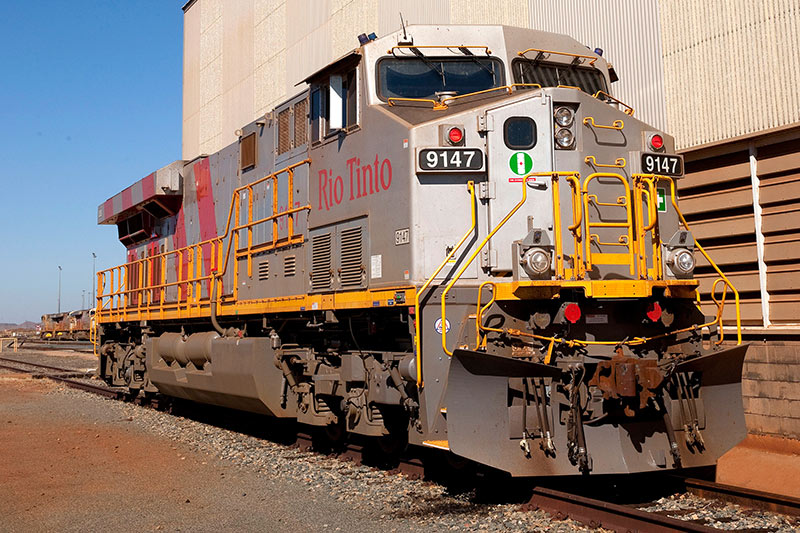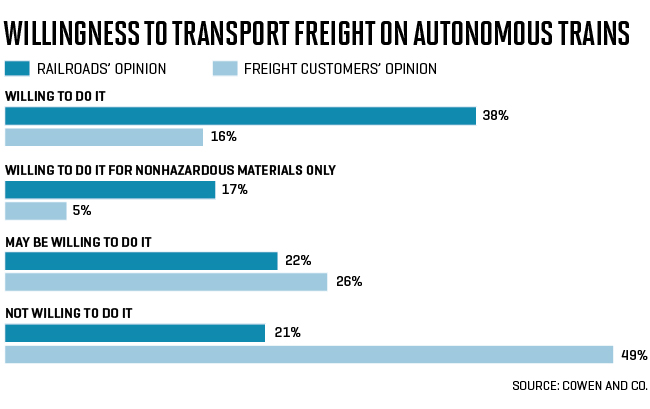无人汽车方兴未艾,无人火车又要来了

|
如果一切顺利的话,今年8月,一列完全由电脑控制的货运列车将在科罗拉多州普韦布洛市附近的一条铁路上进行试运行。这列几千吨的庞然大物将完全依靠人工智能和传感器技术运行,人类列车员只负责观察。 本次试验将在一段48英里长的试验路段上进行,但它标志着无人列车技术迈出了重要的一步,其结果甚至有可能彻底改变铁路行业的格局。 铁路运输仍然是一项规模庞大且利润丰厚的业务,但跟10年前相比,铁路的运量明显有所下降,其最大客户——煤炭行业也经历了长期的衰退。美国政府的最新数据显示,2017年,美国有价值约7000亿美元的货物是通过铁路运输的,相比之下,通过公路运输的货物则要多出很多,其价值超过了12万亿美元。 为了赶上公路的运力,铁路公司必须能够吸引那些增长速度较快的国民经济部门,比如需要更快更可靠的寄递服务的电商行业。因此,铁路公司也对自动化技术抱以厚望,因为它可以让火车跑得更快,并且缩短各个班次的间隙,从而降低燃油成本,提高铁路运力。 投资公司Cowen and Co.的分析师马特·埃尔科特表示:“我认为在这方面并没有太多争议,这就是铁路行业需要走的方向。”在埃尔科特看来,铁路行业在5至7年内就将实现大规模的自动化。 在此背景下,各大铁路公司竞相发力,希望将人工智能、机器学习等高新技术整合到铁路系统中。西门子、西屋制动(Wabtec)和克诺尔(Knorr-Bremse)等老牌铁路设备制造商也在积极与英伟达、微软、日立等科技公司展开竞争。 |
If all goes as planned in August, a freight train will chug down a track near Pueblo, Colo.—entirely controlled by computers. Humans in the locomotive will merely observe, as the latest in artificial intelligence and sensor technology puts thousands of tons of steel through its paces. The experiment, on 48 miles of track at the railroad industry’s advanced testing ground, is a big step in the push for autonomous train technology. The outcome could fundamentally alter the railroad industry. While still a huge, highly profitable business, railroads move less freight than they did 10 years ago, and their biggest customer—the coal industry—is in long-term decline. Almost $700 billion in cargo moved by train in 2017, the latest government figures show, but trucks carried far more, over $12 trillion. To catch up, rail companies must appeal more to faster-growing segments of the economy, like e-commerce, which require speedier and more reliable deliveries. Automation, railroads hope, is the answer because it could reduce fuel costs and increase capacity by enabling trains to run faster and closer together. “I don’t think there’s much debate: This is where the railroads need to go,” says Cowen and Co. analyst Matt Elkott, who forecasts extensive automation in the industry within five to seven years. That reinvention effort is setting off a race to add A.I., machine learning, and other high-tech features to the rail system. Age-old railroad equipment makers like Siemens, Wabtec, and Knorr-Bremse are up against tech companies like Nvidia, Microsoft, and Hitachi. |

|
无人列车技术所需要的大多数高科技元件,实际上早已经相继投入应用了——比如用来降低燃油消耗和控制紧急制动系统的元件等。我们需要的只是利用人工智能技术将它们整合到一起,并且通过测试,说服所有利益相关方接受列车无人化的大趋势。 不过即使有关测试进展顺利,无人列车也依然面临一些挑战。首先是强大的铁路行业工会,他们在保持员工规模的问题上一贯是激烈抗争的。其次,公众可能会担心无人列车的安全性问题,这也是行业必须要解决的一个问题。最后,监管机构可能会对这项技术持有怀疑态度,但无人列车技术要想普及,就必须获得监管部门的盖章审批。 此次将在科罗拉多州试验的技术来自于纽约空气制动公司(New York Air Brake),该公司的首席执行官乌利塞斯·卡米洛表示:“当然,我们是有能力做到的,问题是以多快的速度。” 实际上,无人列车技术的基础在美国已经打下了。这还要归功于美国出台的一项升级北美铁路系统安全性的规划。该规划耗资100亿美元,历时达12年之久,到明年升级就应该结束了。该计划是在2008年加州火车相撞事故后启动的。那一年,有一列通勤列车与一列联合太平洋铁路公司的货运火车迎头相撞,导致25人死亡。事故原因是一名列车驾驶员粗心大意闯了红灯。 事故发生后,美国国会要求整个铁路系统必须对安全功能进行升级,实现自动化安全控制。该项目又被称作“积极列车控制系统”,简称PTC。PTC的任务之一,便是在铁轨和道岔上加装传感器,以便向中央服务器发送信息,告诉火车前方的交通和路况。如果列车驾驶员未能减速或停车,系统可以自动进行干预。不过就其本身而言,PTC只具备处理少数几种紧急情况的能力,比如未按信号灯行驶,或者在急转弯时车速过快等。 从某些方面看,铁路应该可以借鉴无人驾驶汽车的很多技术,比如摄像头、雷达和光探测技术等——不过无人列车和无人汽车也有很大的区别,比如要让一辆货运火车停下来,至少需要1英里长的刹车距离(一辆快速行驶的汽车大约需要300英尺)。 |
Most of the tech components—including ones that reduce fuel consumption and control emergency braking systems—have already been deployed in piecemeal fashion. What’s needed is A.I. to tie them together and testing to persuade all the stakeholders to go along for the ride. But even if the tests go well, autonomous trains face several challenges. The first is powerful railroad unions, which have fought bitterly over crew sizes. Next, the industry would have to overcome public fears that autonomous technology is unsafe. And finally, sometimes-skeptical regulators would have to give their seal of approval. “Of course we’ll be able to do it,” says Ulisses Camilo, CEO of New York Air Brake, the company whose technology will be tested in Colorado. “The question is how fast.” The groundwork for autonomous rails was laid as part of a 12-year, $10 billion safety upgrade to North America’s system that should be completed by next year. The overhaul started in 2008, after 25 people died in the head-on collision of a commuter train and a Union Pacific freight train in Chatsworth, Calif. (a distracted engineer blew past a red signal light). In response, Congress mandated that the entire system be upgraded with automatic safety overrides. Known as Positive Train Control, or PTC, the program includes sensors on tracks and switches that send information to central servers, telling trains about traffic and conditions ahead. If an engineer fails to slow or stop a train, the system can automatically intervene. Still, by itself, PTC is equipped to handle only a few types of emergencies, like a missed signal or a train traveling too fast around a sharp curve. In some ways, the railroads should be able to adapt or borrow from many of the camera, radar, and lidar technologies used in self-¬driving cars and trucks. One big difference: Stopping a freight train can take a mile or more (versus 300 feet for a fast-moving car). |

|
目前,力拓集团(Rio Tinto)在澳大利亚已经开始使用全自动列车,从16座矿山向数百英里外的港口运送铁矿石。截至去年年底,该公司的无人列车已经安全行驶了近300万英里。 尽管列车自动化有很多潜在的好处,但各大铁路货运公司都不愿意就这个问题向《财富》杂志发表评论。这也是可以理解的,毕竟今年秋天的工会谈判在即,眼下可以说是一个敏感时期,尤其是一些铁路公司可能会提议将列车车组人员从两人削减到只剩一人。 铁路行业的工会则认为,自动化只不过是资本家裁员的另一手段。去年,美国联邦铁路局曾经就铁路无人化公开征求意见,最后一共收集到3400多条意见,其中99%都是反对意见。 美国铁路工人联合会的特别代表弗里茨·埃德勒表示:“这项技术确实很花哨,但它还没有迎来它的黄金时代。”他指出,将车组人员削减到一人,同时高度依赖自动化,“无疑是危险的。” 美国联邦政府目前尚未推动无人列车计划,不过它在今年6月貌似就已经表明了它在这个问题上的立场——美国政府否决了奥巴马时代的一项关于将货运列车车组人员固定为2人的立法提议。 就在铁路行业还在就自动化展开激辩的时候,与之竞争的公路运输行业仍然在自我革命,无人驾驶技术和电动汽车的应用,都会大幅降低公路运输的成本。 对此,运输行业的一名独立分析师托尼·哈奇表示:“铁路行业对此必须做出反应。”(财富中文网) 本文原载于《财富》杂志2019年8月刊。 译者:朴成奎 |
Already, mining giant Rio Tinto is using fully autonomous trains in Australia to deliver iron ore from 16 mines to ports hundreds of miles away. By the end of last year, the company said it had safely completed almost 3 million miles of autonomous travel. Despite the potential benefits of automation, major freight railroads declined to comment to Fortune on the issue. Union negotiations in the fall make this a sensitive time, particularly because railroads will likely propose reducing train crews to just one person from two. Railroad unions see automation as yet another effort to reduce their ranks. When the Federal Railroad Administration asked for public feedback last year about autonomous rail, it was flooded with 3,400 comments, 99% of which were in opposition. “The technology is flashy, but it is not ready for prime time,” warns Fritz Edler, special representative for the Railroad Workers United union. Reducing train crews to one person and depending on automation would be “demonstrably dangerous,” he says. The federal government hasn’t moved forward with a plan for ¬autonomous trains yet, but it may have showed its hand in June when it killed an Obama-era proposal that would have enshrined into law two-person crews. Even as the railroad industry debates automation, the rival trucking industry is pushing ahead, with both self-driving technology and electric vehicles that may be much cheaper to operate. Says Tony Hatch, an independent transportation industry analyst: “The railroads have to respond.” This article originally appeared in the August 2019 issue of Fortune. |











